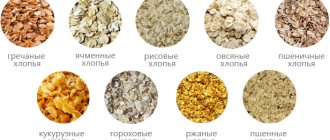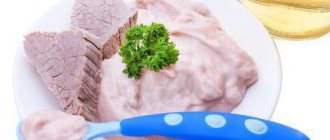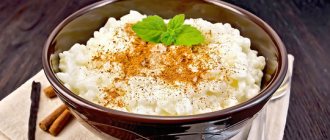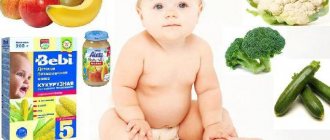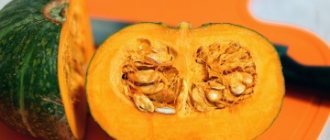Properties of pumpkin
Pumpkin is a very tasty and healthy vegetable. Thanks to its low calorie content and very rich content of vitamins, minerals, micro- and macroelements, it can be called a natural pharmacy that helps the body get rid of many diseases. It contains vitamins A, C, E, F, D, PP, T, group B, as well as iron, magnesium, potassium, calcium, copper, phosphorus, cobalt, and fiber necessary for the intestines. Therefore, it is useful to give pumpkin to babies and nursing mothers.
Pumpkin has gained fame due to its anti-inflammatory, cleansing, wound-healing and vasodilating properties. Its sweetish pulp has a calming effect on the nervous system, improves the functioning of the gastrointestinal tract, and stabilizes the body's metabolism. Having a high content of beta-carotene, this vegetable has a beneficial effect on bone growth and vision of the child.
Pumpkin activates the thymus gland, the child’s immune organ responsible for the formation of a strong and healthy immune system.
Freezing for the winter
Delicious pumpkin can be frozen for future use. During freezing, all vitamins, minerals and other valuable substances are preserved in it. This will allow you to feed your baby nutritious and healthy complementary foods throughout the year.
To freeze the product, you need to cut it into small slices, place them on a cutting board and place them in the freezer for 1-1.5 hours. After this, the frozen slices must be packaged in separate, hermetically sealed plastic bags and placed back in the freezer.
Benefit
The first vegetables, fruits and berries on a child’s menu play an important role in shaping his health. That is why they must be introduced gradually and correctly so that the baby gets the maximum benefit from them. Pumpkin is a hypoallergenic product, so it can be introduced into complementary foods at the same time as zucchini, carrots and broccoli.
Important! All these vegetables should be given to the baby for testing one at a time in order to immediately understand how the child’s body reacts to them.
Pumpkin, broccoli, carrots and zucchini are easily digestible and have a beneficial effect on the digestive system. Pumpkin has a fibrous structure and contains a fairly large amount of fiber. It will help with increased stomach acidity and constipation, because it is a good laxative, helping the child to empty the intestines, this is its great benefit for digestion. And pumpkin juice relieves bloating and pain in the tummy (just remember that freshly squeezed pumpkin juice in its pure form cannot be given to babies, it must be diluted with water in a 1:1 ratio). This is why pumpkin is very suitable for a child who has problems with the digestive system.
The vitamin C contained in pumpkin makes up a quarter of the baby’s daily dose, so consuming this “golden” vegetable strengthens the body, helps it fight viruses and infections, and prevents the development of colds. Iron, which is much more abundant in pumpkin than in apples, increases hemoglobin and prevents the development of anemia in an infant. The presence of B vitamins, magnesium, potassium and other microelements in the chemical composition makes pumpkin indispensable for the formation of a healthy immune, circulatory and nervous systems, and vitamin D will prevent rickets.
A big plus for always-busy mothers of infants is the fact that pumpkin can be prepared very easily and quickly, and thanks to its sweet taste, giving pumpkin to a baby is quite simple. A newborn usually likes this type of feeding.
Pumpkin puree for babies: from how many months can you give your baby pumpkin?
Pumpkin is a healthy and tasty vegetable that is used for making porridges and soups, mousses and desserts, pies and pastries, juices and smoothies, salads and various main courses.
Due to its bright color, it can cause an allergic reaction, so you should be careful when introducing this product into your baby’s diet. In this article we will find out at what age you can give this vegetable to your child.
And we will learn how to cook pumpkin for complementary feeding correctly.
Beneficial features
- Saturates the body with important elements. Among which are healthy fats, zinc and iron, vitamin D and A, E and K;
- Positively affects the growth and development of the child;
- Increases the body's immunity and defenses, eliminates germs;
- Cleanses the body, removes toxins and harmful substances, has a diuretic effect;
- Relieves fatigue and stress, has a beneficial effect on the functioning of nerve cells, gives strength and energy, tones;
- Improves heart function and strengthens the walls of blood vessels, normalizes blood pressure;
- Strengthens gums and teeth, bones and bone skeleton;
- Increases visual acuity;
- Normalizes skin condition;
- Reduces weight and regulates material metabolism;
- Stimulates brain function, improves attentiveness and memory;
- Helps with diseases of the biliary tract, kidneys and liver;
- Improves the functioning of the intestines and digestion;
- Pumpkin seeds relieve inflammation, have a laxative effect and eliminate constipation in infants.
About the benefits
Pumpkin is a vegetable typical of our region, so it is well digested even by the smallest. Compared to its “colleagues”, it has a very wide spectrum of action and is enriched with many elements, including:
- Iron, phosphorus, potassium, calcium, magnesium.
- B vitamins.
- Ascorbic acid.
- Vitamin E.
- Beta-carotene.
And that's not all, but only basic vitamins and minerals. Based on this list, we can highlight the following areas of beneficial effects of pumpkin for a baby.
- Has a beneficial effect on the development of the skeletal and muscular systems.
- Magnesium has a positive effect on the nervous system, relieves muscle tone, and promotes sound sleep.
- Vitamin C strengthens the immune system.
- Potassium is necessary for the full functioning of the cardiovascular system.
- Iron prevents the development of anemia and anemia.
- A large amount of fiber promotes gastrointestinal health.
- Beta-carotene is beneficial for the baby's visual system.
It should also be noted that pumpkin puree for babies is easily digestible, it contains a lot of water and fiber, so the product can be called dietary.
With all the benefits, the vegetable has almost no contraindications. The only thing you should pay attention to is that pumpkin increases the amount of bilirubin in the blood, that is, it can cause jaundice.
However, this phenomenon can only be observed when the product is overeated.
Pumpkin: is it harmful to babies?
However, pumpkin can also be harmful to the child’s body. First of all, the vegetable contains carotene, due to which it acquires its bright color. This increases the risk of food allergies.
Unwashed, stale fruits and vegetables grown with the addition of nitrates and various chemicals cause severe poisoning and the development of intestinal infections. This can lead to digestive problems, causing bloating, cramps and fermentation processes in the abdomen.
Therefore, it is advisable to use only fresh crops grown in your region. And before eating, thoroughly wash and peel the vegetables! When cooking, use a minimum of sugar and salt, as spices also cause stomach upsets and allergic reactions.
Pumpkin should not be introduced into complementary foods if the child has individual intolerance and diabetes. It is not recommended for diseases of the stomach and small intestine.
How to choose a quality product
When choosing a vegetable as the first complementary food for a baby, it is recommended to follow the following rules:
- Give preference to medium-sized vegetables.
- Buy only ripe, but not overripe pumpkins, and make sure there are no spots, dents or rotten areas.
- If you decide to buy a cut pumpkin, then opt for the brightest orange fruits.
Choosing a quality product for a child is always a difficult task. However, there are a few rules that will help you buy the best pumpkin for your baby.
- Never buy a cut pumpkin, or a vegetable that shows signs of rot or diaper rash.
- For children, it is better to choose a vegetable with green or white skin.
- Don't worry if you notice a waxy coating on the peel - this is a natural wax that the vegetable itself produces.
- It is better to buy a pumpkin weighing 3-5 kg.
- If the tail of a vegetable is cut off, it means the fruit is not ripe.
- The skin should be dense and not susceptible to pressure with a fingernail.
From how many months can you give
Pumpkin is introduced into the baby’s diet after zucchini, cauliflower and broccoli. These are hypoallergenic and the safest vegetables, which are suitable for the first complementary feeding as early as 6 months. Pumpkin puree can be given to a baby at seven months. Pumpkin for children under one year of age is introduced gradually in compliance with the rules of complementary feeding.
For the first feeding with pumpkin, give the baby half a teaspoon of puree, carefully monitor the baby’s well-being. If you notice symptoms of a food allergy, eliminate the product from your diet and contact your pediatrician.
Allergic reactions manifest themselves in the form of redness, itching, peeling and swelling of the skin. In addition, swelling, runny nose and watery eyes, slight fever and cough, nausea and vomiting can sometimes be observed.
If the baby feels well, there are no allergies or negative consequences, you can safely eat the introduced vegetable in small quantities up to two or three times a week. Older children prepare various dishes using pumpkin, including casseroles and desserts, drinks, soups, stews, and so on.
Children should not be given raw pumpkin, otherwise it will cause indigestion and diarrhea. Pumpkin seeds have a mild laxative and anti-inflammatory effect. They are used dried or raw. A fried product loses most of its beneficial properties. However, seeds are not recommended for children under three years of age.
How to cook pumpkin correctly
To prepare pumpkin puree, peel and cut the vegetable into slices, add water and bring to a boil. Then simmer under the lid for 20-25 minutes. The prepared pieces are pureed or blended in a blender. For babies up to one year old, breast milk or ready-made formula is added.
In addition, you can cook pumpkin in a slow cooker, steamer, or bake in the oven. To cook in a slow cooker, select the simmer mode for forty minutes. Twenty minutes is enough to cook in a double boiler.
Source: https://zdorovo16.ru/pitanie/tykva-prikorm-rebenku-so-skolki.html
Contraindications. Possible allergic reaction
Are there any contraindications to eating pumpkin in children? Does the vegetable strengthen the intestines or weaken them? It is not recommended to give this vegetable in the following cases:
- hepatitis (congenital or acquired);
- diabetes;
- failure of acid-base balance;
- allergy to pumpkin in an infant.
Today, many mothers are concerned about the question: “Can allergic reactions to pumpkin and pumpkin juice occur in a newborn?” Considering that pumpkin itself is hypoallergenic, it is inappropriate to talk about allergies. But you should remember the individual characteristics of each organism, so it is certainly impossible to predict in advance the reaction of the child’s body to the product used with a 100% guarantee. The immune system may react with intolerance to vitamins and other elements contained in pumpkin. Also, a negative reaction can be caused by the chemicals used in growing the product. Therefore, when starting complementary feeding with pumpkin, you need to follow all the rules for the timely and gradual introduction of complementary foods.
Pediatricians recommend starting to introduce “adult” foods into a baby’s diet no earlier than 5 months and starting with green vegetables
It is recommended to give pumpkin dishes no earlier than 7 months: the bright orange color of the fruit is a warning that you need to be careful with it!
In children, an allergy to pumpkin is very rare and can be expressed by redness on the cheeks or a rash on the body, as well as a stuffy nose and throat. Depending on the characteristics of the body, a child’s allergy to pumpkin may appear within two to three hours after ingestion and most often goes away on its own within two to three days with plenty of drinking. Although she does not pose any particular danger, she still needs to see a pediatrician.
Important! In the case of pumpkin, an allergic reaction is very rare. Therefore, in 98 cases out of 100, the cause of a child’s allergy must be sought in another product.
By the way, mothers who are breastfeeding need to be especially careful about their diet. Since the baby’s body can react to any allergen that comes from breast milk. Antihistamines are not suitable in this case, as they can harm the child.
Valuable qualities of the product
- Valuable vitamin and mineral complex. A special place is occupied by beta-carotene, ascorbic acid, B vitamins, vitamin D, iron, silicon and calcium. They help strengthen the body's immune system, improve vision, increase hemoglobin, and influence the proper growth and development of bones and teeth.
- High pectin content. Improve metabolic processes in the body, promote the removal of waste and toxins.
- Fiber is contained in sufficient quantities. Provides better absorption of food, promotes better digestion. In baked and boiled form it helps fight low acidity, and in the form of juice it resists flatulence.
- Helps relieve depression, improves psychological state, sleep becomes more restful, and increases brain activity.
- It is a preventive agent in the development of pathologies of the liver, gallbladder and bile ducts.
- It has a diuretic effect, which has a beneficial effect in the presence of pathologies of the excretory system.
- It is a low-calorie product, so it is acceptable in the diet of overweight children.
- The seeds also have a high content of minerals, vitamins, and fatty acids. A special place is occupied by vitamins D, A, K, and tocopherol; minerals: zinc and iron.
- The seeds have a moderate laxative effect, act as an anti-inflammatory agent, and are also a good anthelmintic and improve the digestion process.
Minuses
- The risk of developing so-called carotene jaundice. The cause may be excessive consumption of this vegetable.
- Contraindications to consuming pumpkin are a history of hepatitis and diabetes.
- Not recommended for inflammatory processes in the stomach and intestines.
- Roasted seeds can increase cholesterol and develop atherosclerosis. This is due to the fact that during the frying process, valuable qualities are lost and harmful substances are acquired.
When to start giving
Complementary feeding is one of the important stages in the development of babies. At what age can you start introducing your baby to “adult” food? There is an opinion that bottle-fed infants should be introduced to solid food a little earlier than babies who are fed breast milk, since in “artificially-fed” babies the digestive system adapts to “adult” food more easily and quickly. Children's doctors advise starting to introduce complementary foods between 4 and 6 months. Although the well-known pediatrician E.O. Komarovsky believes that regardless of what the baby eats - formula or breast milk - new dishes should be offered to the child only after 6 months.
Answering the question at what age can you offer your child pumpkin dishes, it is worth noting that zucchini, carrots and broccoli should be the starting point for complementary feeding, and only then pumpkin. How much should I give? You need to start with half a teaspoon of food new to the baby and gradually double the portions, “reaching” 40 grams in combination with other vegetables, you can safely replace 1 feeding with an “adult” dish.
To begin with, pumpkin for babies, like all the other vegetables listed above, is given in the form of a liquid puree
After a year, you can cook pumpkin soup or porridge for your baby, and baked pumpkin will also be useful.
Can children have pumpkin, at what age, how much?
Giving your baby pumpkin is beneficial from the first year of life. This vegetable provides the body with vegetable protein, carbohydrates, essential vitamins, stimulates the development of internal organs and overall growth. And the delicate taste rarely leaves kids indifferent. But you can include pumpkin in complementary foods only in the absence of food allergies and certain diseases.
Benefits and harms of the product
Pumpkin pulp does not contain organic acids that irritate the mucous membranes of the gastrointestinal tract and is easily digested. Ripe fruits are rich in carotene, vitamins E, K, C, group B, necessary for metabolism, synthesis of muscle and skeletal tissues. Pumpkin contains a lot of iron, magnesium, zinc, calcium, silicon and other minerals involved in the construction of new cells, the functioning of the nervous and vascular systems.
The pectins contained in the vegetable cleanse the blood, lymph, ducts and intestines of toxins. Pumpkin dietary fiber is loose, does not cause a feeling of heaviness in the stomach, but perfectly stimulates peristalsis and prevents constipation. In addition, pumpkin is useful for children for strengthening the immune system, the full formation of the visual apparatus, and the normal functioning of the heart, kidneys, and brain.
This vegetable can cause harm in cases of hepatitis, diabetes, acute inflammation of the stomach and intestines, and a tendency to food allergies.
How to properly introduce complementary foods
The age at which a baby can eat pumpkin is 7–9 months.
By this period, it is recommended to introduce the baby to several types of vegetables: zucchini, cabbage, potatoes. It is advisable to start feeding artificial animals with pumpkin 1–2 months earlier. For babies, the product is given in the form of pureed, homogeneous puree from boiled vegetables.
- The first portion is no more than ⅓ tsp. It is given to the child to try after morning feeding, without mixing with other foods.
- The next portion is doubled, then 3-4 times, gradually increasing to 50 g.
- Children under one year old can be given pumpkin 2-3 times a week. You should not overuse it; overeating can cause carotene jaundice - excess pigment will stain the skin.
- For babies over 1 year old, you can give an additional portion per week, and the volume can be increased to 70 g.
- Children over 2 years old are allowed to eat up to 150 g of pumpkin without fear; if they wish, they can try the raw vegetable in salads and prepare a variety of dishes: porridge, soups, casseroles.
- For children over 3 years old, portions are increased to 200 g.
The best time to eat pumpkin is autumn and winter.
By this period, the crop ripens, and can be stored, remaining fresh, until spring. A thick crust protects the product from spoilage. She doesn't need a refrigerator, a dark, dry space is enough. Vegetables cut into pieces can be kept in the freezer for several weeks.
Which pumpkin to choose for a child
It is not advisable to use huge fruits for baby food. They have a rough structure and poorer taste. More suitable are pumpkins weighing up to 4 kg, bright yellow or orange in color, without cracks or dark spots.
The cut flesh should be juicy, with a light fresh aroma. Children should not buy halves or slices; only whole fruits are suitable. A damaged vegetable quickly loses its beneficial properties, dries out, and harmful microbes can multiply on its surface.
Pumpkin dishes for children
Thanks to its juicy, loose pulp with a slightly sweet taste, pumpkin is a universal product. It can be boiled, eaten raw, baked, cooked in pies, cereals, desserts, soups. Among the recipes undesirable for children are only fried foods. Hot fat destroys most of the minerals and vitamins in the product.
How long does it take to cook pumpkin for a child? It does not require long-term heat treatment. 20–30 minutes in boiling water or a slow cooker is enough. It is preferable to cook it steamed or in the oven - the vegetable retains more of its own juice and does not lose its taste.
Pumpkin soup for children
To prepare you will need:
- a piece of pumpkin weighing 150 g, peeled and seeds removed;
- small carrots;
- bulb;
- ½ cup cream or 2 tbsp. l. vegetable oil;
- potato.
Potatoes, onions and pumpkin are cut into small cubes, carrots are chopped. Pour 500 ml of water over the vegetables and simmer over low heat until they soften. Allow the soups to cool slightly, add butter or cream.
Pumpkin puree for children
Cut the fruit into 2–3 cm pieces, place in a saucepan, and fill half the volume with water. Cook over low heat, covered, until the pumpkin is soft. Drain the remaining water and puree the vegetable. Add a little butter or milk if desired.
Pumpkin Dessert Casserole
For preparation:
- pumpkin - 300 g;
- apples - 300 g;
- bananas - 2 pcs.;
- powdered sugar - 2 tsp.
Cut pumpkin and apples into slices. Bananas - mash into puree. Place the products in the mold in layers, sprinkling each with powdered sugar. Add ¼ cup of water to the bowl. Bake in the oven for 30 minutes.
Source: https://PitanieMalysha.ru/racion/mozhno-li-detjam-tykvu-s-kakogo-vozrasta-skolko/
Rules for “pumpkin” feeding
When feeding your baby, you need to follow the basic rules:
We recommend reading: How to make broccoli puree for babies
- the first time you can give 1/2 teaspoon of liquid pumpkin puree in the first half of the day. This is done in order to be able to monitor the reaction of the child’s body to a new product;
- if the child is sick or has the slightest manifestation of allergies, it is better to wait with complementary foods;
- food temperature should be about 40 degrees;
- the gap between each new product should be at least two weeks, it is better not to rush;
- You need to feed your baby with a spoon, even if the puree has a thin consistency.
Any new product, including pumpkin, should be offered to the baby as a mono-dish. This will help you immediately understand whether your child is allergic to a specific vegetable.
At what age can you give your baby pumpkin: how to cook it, when to introduce it into baby food
Pumpkin puree is one of the healthiest and most delicious products that are used as complementary foods for babies. Typically, pumpkin is included in the diet after the baby has mastered other vegetables, namely broccoli and zucchini. At what age can you give your child pumpkin? How to properly prepare pumpkin for the first feeding?
Pumpkin is one of the most popular baby food products.
Benefits of pumpkin
Pumpkin has a number of positive properties. In addition to the fact that the product is very useful for the growth and development of the baby, it will also delight the little gourmet with its pleasant taste and attractive appearance.
Additional benefits of pumpkin include:
- Easy transportation over long distances;
- Long shelf life due to very thick crust. Such protection, on the one hand, complicates cooking, but on the other hand, it ensures that the vitamin and mineral composition of the pumpkin remains unchanged.
Composition and nutritional value
The usefulness of pumpkin for a growing body is explained by the large number of trace elements it contains. It contains the following components:
- Vitamins of group B, A, K, T, C, PP, E;
- Beta carotene;
- Minerals: phosphorus, zinc, iron, sodium, copper, magnesium, calcium, potassium;
- Fatty acid.
Since pumpkin contains very few calories, the product is suitable for all newborns, regardless of body weight (even if the baby is overweight).
On a note. The brighter and more saturated the color of a vegetable, the more beta-carotene it contains.
The beneficial properties of the product include the following:
- Strengthens the baby's immunity (pumpkin contains a large amount of ascorbic acid).
- Due to vitamin B, it has a sedative effect on the central nervous system and helps you fall asleep faster.
- Promotes active growth of bone tissue.
- Makes skin healthier.
- Improves the ability to remember and concentrate.
- The product is useful for diseases such as myopia, night blindness, and retinal problems (due to the content of vitamin A and beta-carotene).
- Strengthens the cardiovascular system.
- Improves metabolism and digestion (fiber contributes to this).
- Serves as a prevention of anemia (due to the presence of iron).
- Slows down cell aging, enhances the properties of vitamin A (due to the retention of vitamin E in pumpkin).
- Cleanses the body of toxins and removes excess fluid. According to the famous pediatrician, E. Komarovsky, the pectins contained in pumpkin rid the body of waste and toxins, and also eliminate pathogenic microorganisms.
- Provides prevention of osteoporosis.
- Due to the presence of vitamin T in pumpkin, active formation of muscle mass occurs.
- The trace elements included in the vegetable, sodium and potassium, have a diuretic effect and prevent the formation of edema.
- Prevents the development of inflammation.
- Pumpkin seeds reduce blood cholesterol levels and stimulate the production of serotonin.
On a note. Pumpkin puree is quickly and easily digestible.
Useful properties of pumpkin
In what form can it be given?
Prune decoction for babies - how to prepare
The easiest way is to use a standard cooking recipe. However, if the mother wants to diversify the baby’s diet, you can prepare the product in different forms and according to different recipes. As a result, the vegetable can turn out:
- Stewed;
- Boiled;
- Baked;
The product can be added to other dishes (soup, porridge).
At first (at six months of age), pumpkin complementary foods are given in the form of pure puree (without additives). After the baby turns one year old, he can be treated to pumpkin juice; from 10 months, adding pumpkin seeds is allowed. Combination with other products (meat, fruits) is carried out as they are introduced into children's complementary foods.
As the child gets older, the list of acceptable dishes using pumpkin will increase greatly. Mom will be able to give her child:
- Pumpkin soup;
- Pumpkin puree for babies (used as a side dish for meat, fish or eaten separately);
- Pumpkin chips;
- Pies, cupcakes;
- Salad;
- Dried fruits;
- Fruit pilaf;
- Homemade sweets.
Pumpkin puree
When can it be introduced into complementary foods?
Do-it-yourself zucchini feeding for babies
Many parents wonder from how many months old can they give pumpkin to their baby. Puree from this vegetable can be added to the diet when the baby is 7 months old. It is not at all difficult to accustom your baby to this product: you need to act by analogy with how other vegetables were introduced into complementary foods. However, certain nuances are still present.
At the initial stages, the amount of food per feeding should be very small - about half or a third of a teaspoon. Quite often, infants spit out the orange vegetable because they find it tasteless. In this case, you should try again.
If the baby has taken puree, feeding should be stopped for 2-3 days. During this time, you should observe the behavior and well-being of the baby.
If the baby does not have any problems with digestion, redness or rashes on the skin do not appear, then puree can be safely introduced into complementary foods.
The process of adding pumpkin to the standard diet of a newborn must comply with the following rules:
- The vegetable is given in the morning or before lunch.
- At first, the puree is given in its pure form (without adding anything or mixing with anything).
- Complementary foods are introduced gradually and the baby's condition is monitored.
- Do not give the product if the child is sick or has been vaccinated.
How to cook pumpkin
Before you start cooking, you need to familiarize yourself with the rules for selecting and storing the product.
Carrot puree for babies - recipe
When buying a vegetable, you should pay attention to the following points:
- There should be no signs of rotting on the surface of the pumpkin.
- The bright color of the product indicates that the pumpkin is very sweet.
- A dry stalk indicates the ripeness of the vegetable.
- If you knock on it, a dull sound will be heard.
- There should be no damage or dented areas on the peel.
- If you plan to buy only part of the pumpkin, you need to assess the condition of the seeds - they should be hard. Empty seeds indicate that the vegetable is not yet ripe;
- The pumpkin and cut surface should look fresh;
- The weight of the fetus should be 3-5 kg. Young crops have this mass, the pulp structure of which has much less fiber. Thanks to this, the vegetable cooks faster and the puree is more tender.
The product is stored in a cool, dark and dry place with an air temperature of 5 to 15 degrees. In such conditions, the pumpkin will not spoil even after 4-6 months. As for the actual preparation, it is better to start with a homogeneous consistency, without mixing the puree with other ingredients.
On a note. Many mothers prefer not to waste time on cooking and purchase ready-made complementary foods in the store. However, we should not forget that the usefulness of such puree may not justify itself.
How long to cook
The cooking time depends on the cooking method.
Cooking duration
Puree recipe
The recipe for pumpkin puree for babies involves step-by-step steps:
- First, the pumpkin is doused with boiling water to remove dirt and pathogenic microorganisms.
- The product is cut into pieces.
- Remove the seeds.
- Remove the skin from the pumpkin and chop the pulp into cubes.
- The product is placed in a frying pan, poured with water so that the pumpkin pieces are lightly covered with it.
- Boil the vegetable for 15 minutes. When the product softens, you can remove the pan from the stove.
- The slices are crushed using a blender. If you wish, you can add a small amount of pumpkin broth to the resulting mass.
- If the baby is already 7 months old, 2-3 drops of olive oil as an addition to the puree will not be superfluous.
If the crumbs’ menu already contains (or was previously included in the diet) foods such as bananas, apples, milk, then they can also be added to the puree. For ease of operation, it is recommended to use a multicooker.
On a note. The best seasons for pumpkins are winter and autumn.
Complementary feeding standards
The amount of food that can be given to a newborn baby depends on the age of the baby. In this regard, there are special standards for complementary feeding by month.
What can be combined with
Pumpkin can be combined with a wide variety of foods. These include:
- Bananas;
- Apples;
- Pear;
- Broccoli;
- Turkey;
- Beef;
- Chicken;
- Potato;
- Carrot;
- Zucchini.
At the first stages of introducing complementary foods, it is allowed to add breast milk to the puree.
Pumpkin puree with apples
How often to give
The benefit of pumpkin complementary foods will only be if you feed it to your child only 2-3 times a week. In this case, a gap of several days should be maintained between feedings.
Important! If these standards are exceeded, the child’s skin may acquire a yellowish tint. There is also a risk of allergies and gastrointestinal disorders.
Quantity
At seven months of age, portions should be minimal - 30 g a couple of times a week. For older children, the volume of pumpkin puree can be made larger - up to 30 g, 3 times a week. One-year-old children can consume about 50 g per feeding, 3 times a week.
Possible nutrition problems
Using pumpkin as complementary food may not always be beneficial. In some cases, such nutrition is generally contraindicated:
- For gastritis in a child;
- For ulcers;
- If the baby suffers from diabetes.
You should also not give pumpkin to children who are allergic to foods high in carotene.
Important! Despite a number of beneficial properties of this vegetable, it cannot be consumed raw. The fact is that a product purchased in a store may contain a large amount of harmful components, for example, nitrates.
Signs of allergies
When consuming purees and other products made from pumpkin, children may experience allergies. The reason is that this vegetable contains a significant proportion of carotene, as well as f225 protein. These components are allergens. Signs of a negative reaction to the product:
- Rash on a random area of the body;
- Itching;
- Nasal congestion;
- Edema;
- Cough, sneezing.
On a note. An allergy to pumpkin usually does not appear immediately, but only after a few days. To simplify the process of monitoring a child, it is advisable to regularly keep records in which information about the baby’s reaction to nutrition will be recorded in a timely manner. If negative symptoms are detected, the product should be immediately excluded from the baby’s diet.
Pumpkin is a very healthy, quite tasty and easily digestible product. In addition, its cost is quite low. For these reasons, pumpkin is often used to feed infants.
One of the most common dishes for which the vegetable is used is pumpkin puree for babies.
However, in order for the product to be beneficial and not cause harm, it is necessary to adhere to certain rules and recommendations for its use.
Source: https://kpoxa.info/zdorovie-pitanie/pyure-iz-tykvy-dlya-grudnichka.html
Dishes for babies
Let's look at how to cook pumpkin for babies in their first year of life. Parents can use recipes and prepare delicious pumpkin dishes on their own - porridge, puree, soup - or bake vegetables, and can also give their child ready-made canned food. As a rule, conscious mothers opt for the first option, although high-quality baby food has never harmed anyone (but it is expensive).
In the case of pumpkin, preparing your own dishes is quite convenient, since the orange vegetable is perfectly stored all winter and does not lose its beneficial properties when frozen.
Interesting! “Pumpkin” vitamins have an amazing property - they are not destroyed by heat treatment, so a boiled vegetable is just as healthy as a raw one.
Pumpkin can be boiled, baked or cooked in a slow cooker (or use it in a double boiler mode). This method of cooking food under pressure in a multicooker-pressure cooker makes it possible to cook dishes many times faster, without losing the nutritional and beneficial properties of the product. The sealed space created in the bowl due to high pressure and hot steam disinfect the product without damaging its structure and preserving vitamins.
One-ingredient pumpkin puree
First, wash it, remove the peel and seeds, then cut it into small cubes and place it in a saucepan with slightly salted water. After the water boils, boil the pumpkin until soft (this usually takes 15-20 minutes, depending on the size of the pieces). Then grind in a blender until smooth or rub the pulp through a sieve. It is advisable to add a few drops of sunflower oil so that all the beneficial substances are better absorbed. If the prepared volume of puree turns out to be more than the child needs for a single feeding, it is recommended to freeze it and then add the prepared pumpkin puree to other vegetables or to soup.
Soup with milk
To do this, boil the peeled and cut into pieces pumpkin in water until half cooked, then pour in boiling milk and finish cooking. Then add a drop of oil and beat with a blender. Preparing this soup in a slow cooker takes much less time. To do this, place the pumpkin cubes in a bowl, add milk and set the desired cooking mode (for example, “soup”).
You can prepare pumpkin soup with milk and feed it to your child instead of puree
With apple
Another interesting recipe. Pumpkin with the addition of an apple is prepared in the same way as the one-component puree described above, only you need to add a baked apple (the pulp cleared of seeds and skin) or a raw green apple, grated on a fine grater, to the blender bowl. You can also combine and add other vegetables and fruits (which are already in the baby’s diet), for example, pear, zucchini, carrots, banana, peach.
Important! Under no circumstances should you mix pumpkin and plum, as both products act as a laxative, and when combined, the child is guaranteed to have indigestion!
Porridge
Pumpkin porridge is offered to the baby after puree and soup have already been tried (after eight months). To obtain it, you need to boil the pumpkin cubes in milk until tender and pour two tablespoons of cereal (semolina, rice, buckwheat or millet) diluted in half a glass of water into the prepared mass, stirring constantly until cooked. At the end, add a little (at the tip of a knife) butter. Sweeten it a little.
So, pumpkin is a very healthy and necessary product in the diet of not only children, but also adults. She is a storehouse of vitamins and minerals. It does not require much effort and time to prepare it. But, despite all its usefulness, it is not recommended to abuse the “golden” vegetable, since even a hypoallergenic product can cause an undesirable individual reaction of the body.
Recipes with pumpkin for children under one year old
Pumpkin+zucchini puree
- Pumpkin – 100 grams;
- Zucchini – 100 grams;
- Water – 1 glass;
- Butter – 0.5 tablespoons.
Zucchini is a valuable source of vitamins, minerals and energy. This is a hypoallergenic vegetable, so it is one of the first to be introduced into baby’s complementary foods. And the combination of zucchini and pumpkin produces a soft and delicate, very healthy puree. To prepare, wash and peel the vegetables, boil the pulp in water and beat the mixture in a blender along with the butter. For babies older than 8-9 months, milk can be used instead of water.
Pumpkin+apple puree
- Pumpkin – 60 grams;
- Green apple – ¼ fruit;
- Water – ½ cup.
Boil the pumpkin separately, cut the peeled apple and mix with the pumpkin pulp. Beat the ingredients in a blender along with water. For taste, you can add a little vegetable oil, breast milk or ready-made milk formula to the puree. The result is a tasty, soft and gentle complementary food that can be given from six to seven months.
Cream soup
- Pumpkin – 60 grams;
- Carrots – 0.5 fruits;
- Egg yolk – 1 piece;
- Milk – 0.5 cups;
- Butter to taste.
We clean the vegetables, finely chop the carrots and put them in boiling water. Cut the pumpkin pulp into pieces and add to the carrots after ten minutes. Cook the vegetables until softened, about 15 minutes. Then transfer to a colander and pour the broth into a separate container. Pour the vegetable mass with milk and add the yolk, grind the components in a blender.
Pour the resulting mixture with strained vegetable broth and bring to a boil. This pumpkin puree soup for a child will be very nutritious and satisfying. It is suitable for children over eight months. You can add a little rice later in the soup.
Pay special attention to the egg yolk. It is less allergic, so it is administered first than protein. At seven months, give your baby a quarter of a boiled egg yolk, then gradually increase the dosage to half and a whole yolk. For a one-year-old child, you can introduce egg white, and then a whole egg. If your baby is allergic to chicken eggs, replace the product with quail eggs.
How to make puree?
Many kids like pumpkin puree because it has a pleasant sweetish taste. You can prepare it in different ways from both fresh and frozen pumpkin. Let's look at each of them in more detail.
How much and how to cook pumpkin?
After filling the peeled pumpkin with water, put the saucepan on the fire, let it boil, close the lid and simmer over low heat for 20 to 25 minutes. You will know the pumpkin is ready when it is tender. After draining the water, press the cooked slices through a sieve to make sure there are no fibers. If necessary, add milk to make the consistency more liquid (for children under one year old - mother’s milk or formula).
In a slow cooker
Take 350 g of pumpkin, separate the peel, fibers and seeds from the pulp, then cut into small cubes. Add 200 ml of water to the vegetable (you can also add a little sugar), place it in the slow cooker and turn it on to the “stew” mode. After 40 minutes, remove the pumpkin, transfer it to a blender and blend until smooth.
In a steamer
After cutting a small piece from the pumpkin, remove the skin and cut the vegetable into cubes. Place them in a steamer basket, place them in the appliance and cook until softened (20 minutes is usually enough). Beat the finished pieces in a blender if your baby has just started trying pumpkin, or mash them with a fork for babies who are learning to chew. After cooling the puree to a warm state, you can offer it to your child.
In the oven
Place the peeled and diced pumpkin in a thick-walled container and add 1/2 cup of water. Bake in the oven for about 15 minutes until the dish is tender. Next, the pumpkin can be passed through a sieve or mashed with a fork, depending on the consistency that your child likes.

